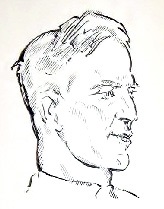During Lawrence’s hurried visits to London throughout his service years, he became adept at cramming in visits to friends, printers, galleries and the theatre, writes Jeremy Wilson in Lawrence in London. But possibly his greatest pleasure was to go walking about the city on his own. Anyone looking to experience Lawrence’s London might therefore do no better than to spend a few hours in the way that Lawrence might himself, wandering the streets, browsing through the bookshops, and savouring all that the city has to offer.
A good starting point might be the former site of the Union Jack Club at 91 Waterloo Road, following a favourite route described by Lawrence himself.
“Up Embankment: Waterloo Road: Strand: St. Martin’s Lane; Charing Cross Road: Tottenham Court Road: Warren Street: tube back to Waterloo.” Voila.’ A map of the city will help the walker find many Lawrence-related diversions along the way.
In the area of the Embankment look out for two statues which both have a link to Lawrence. First, outside the Ministry of Defence building, stands Lord Trenchard, father of the RAF, and a great friend to Lawrence in his service years.
Then wander into Victoria Embankment Gardens to find this most unusual bronze statue erected in 1921 to the ‘Glorious and Immortal Memory of the Officers, NCOs and Men of the Imperial Camel Corps – British – Australian – New Zealand – Indian – who fell in action or died of wounds and disease in Egypt, Sinai and Palestine – 1916 – 1917 – 1918’.
From the Strand, it is a short walk to Covent Garden, where Lawrence’s legend was created, with the opening at the Royal Opera House on August 14 1919 of Lowell Thomas’s show, With Allenby in Palestine and Lawrence in Arabia. Every performance sold out, before it moved to the Royal Albert Hall in November.
‘I emerged in a spotlight and without even saying “Good Evening Ladies and Gentlemen”, I started my show with the words “Come with me to the lands of mystery, history and romance” … Then the pictures began to roll.’
– Lowell Thomas
Three years later, and just a few minutes walk away from the Royal Opera House, Lawrence tried to escape from the legend that Lowell Thomas had created by signing on at the RAF recruiting office in Henrietta Street, as we have already seen.
From the bottom of St Martin’s Lane, it is a few steps away to the National Portrait Gallery, which houses some important portraits
of Lawrence by Augustus John, Eric Kennington and Sir Charles Wheeler. On its website, a room-by-room guide shows which portraits are on display at any time; wandering through the 20th Century galleries will certainly bring one face to face with some of Lawrence’s acquaintances, however.
Today, the Charing Cross Road is well past its heyday as a place to browse for secondhand and antiquarian books; though some of the shopfronts of the specialist bookshops in picturesque Cecil Court, which runs between Charing Cross Road and St Martin’s Lane, are said to have scarcely changed in one hundred years.
In March 1934, Lawrence himself called in at the artist Frederick Carter’s studio in Cecil Court and found himself posing for this drawing: one of the last portraits to be made of him.
To finish this day walking in Lawrence’s footsteps, visits might be made to the British Museum and the Petrie Museum of Egyptian Archaeology at University College London, before heading up Tottenham Court Road to Warren Street for the tube back to Waterloo. Voila!


